Crafting Your Unique Engagement Ring: A Complete Guide

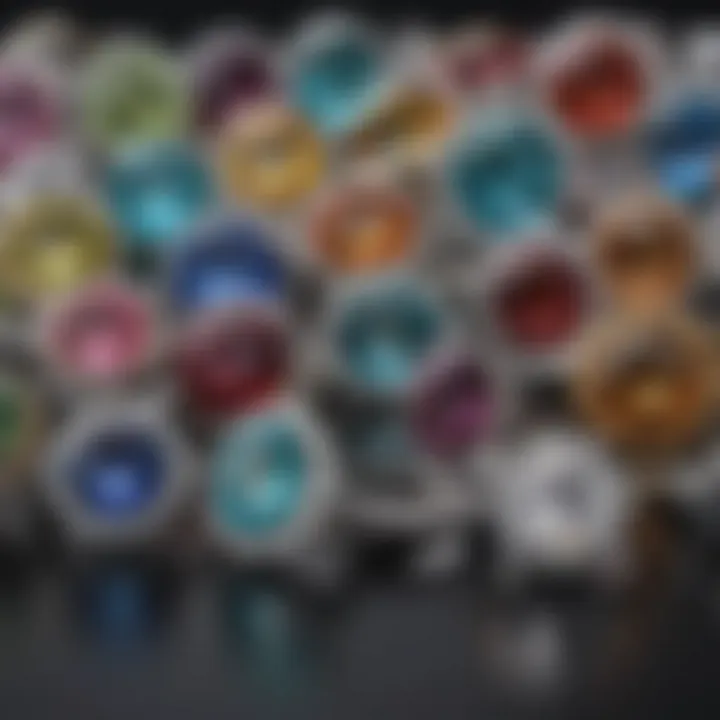
Intro
Designing an engagement ring involves more than just choosing a pretty stone. It is a thoughtful process where personal preferences and craftsmanship play crucial roles. Each choice, from metal type to gemstone selection, contributes to a narrative of love and commitment. This guide aims to provide an in-depth look at the essential aspects to consider when creating a unique symbol of devotion.
Gemstone Overview
Definition and Characteristics
Gemstones are precious or semi-precious minerals that are cut and polished for use in jewelry. Each gemstone boasts distinct characteristics, including color, clarity, cut, and carat weight. These factors significantly influence the overall appearance and value of the stone. A diamond, for example, is renowned for its brilliance and hardness, making it a popular choice for engagement rings. Conversely, sapphires and emeralds offer vibrant hues and unique charm, appealing to those seeking something different.
Classification of Gemstones
Gemstones can be classified into two main categories: precious and semi-precious. The traditional precious gemstones include diamonds, rubies, emeralds, and sapphires. These stones are often more valuable due to their rarity and sought-after qualities. Semi-precious gemstones encompass a broader range of stones such as amethyst, aquamarine, and garnet. They can offer unique aesthetics at diverse price points.
"Understanding the characteristics and classification of gemstones is essential in making informed choices while designing an engagement ring."
Historical Significance
Ancient Uses and Cultural Importance
Historically, gemstones have held a significant place in many cultures. Ancient civilizations believed that certain stones possessed mystical powers. For instance, in ancient Egypt, lapis lazuli was regarded as a symbol of the heavens. The Greeks and Romans associated various gemstones with gods and virtues. Designs that incorporate specific stones often carry these historical meanings, adding depth to the engagement ring's significance.
Myths and Legends Surrounding Gemstones
Gemstones are often steeped in myths and legends. For example, diamonds were once considered to promote strength and invincibility while also symbolizing pure love. Similarly, sapphires were believed to protect their wearers from envy and harm. These stories add a rich layer of meaning to the stones, making them not just beautiful pieces of jewelry but also vessels of historical narratives and cultural beliefs.
Incorporating such thoughts into the design process can enhance the emotional resonance of the engagement ring. Each gemstone can tell its own story, making the ring more than just an accessory—it becomes an heirloom.
Prologue to Custom Engagement Rings
The concept of custom engagement rings is more than just creating a piece of jewelry; it represents a unique journey in personal expression and individual storytelling. When couples consider designing a custom ring, they are not simply shopping for a stone, but they are looking to encapsulate their relationship into a tangible form. This process holds significance for many reasons.
First, custom engagement rings allow couples to incorporate personal symbols, memories, or designs that resonate with their relationship. Each choice, from the type of gemstone to the metal, can reflect moments shared or values held dear. This deeply personal connection to the ring sets custom pieces apart from mass-produced options, which often lack meaning.
Second, engaging in the design process increases the emotional investment in the ring. This involvement often leads to more pride in the final product, as it serves as a reminder of the love and effort put into its creation. Moreover, the experience of collaborating with designers can enhance the couple's bond, making the ring's significance even more substantial.
Additionally, custom engagement rings offer the flexibility to choose ethically sourced materials. In an age where sustainability is increasingly prioritized, many couples seek options that align with their values. By choosing to go custom, individuals can ensure that their choices support ethical practices in the gem and jewelry industry.
As we delve deeper into this guide, we examine crucial factors such as personal style, gemstone options, metals, and the overall design process. By understanding these elements, couples can confidently embark on the journey of creating a ring that is truly one-of-a-kind.
"Designing your own engagement ring can be as significant as the moment you propose. It's a reflection of your love story, carried forever in a beautifully crafted piece."
Whether you are a gemstone enthusiast, a collector, or a future bride or groom, this guide offers comprehensive insights into creating an engagement ring that transcends mere beauty and enters the realm of personal significance.
Understanding the Significance of Engagement Rings
Engagement rings carry deep meaning and personal significance. They are not just ornaments; they represent commitment, love, and a promise for the future. The history behind engagement rings is rich, evolving over centuries. Initially, they came from the ancient Egyptians, who believed a circle symbolized eternity. This sentiment persists today, giving the ring a special place in matrimonial customs.
One of the primary reasons for selecting an engagement ring is its symbolism. The ring is often seen as a public declaration of love. By choosing a custom design, one can incorporate specific elements that reflect individual values or shared experiences. This personalization enhances the emotional connection to the ring. It's important to consider how the design can encapsulate these feelings, making it a lasting reminder of a significant life event.
Moreover, the choice of material and gemstone contributes to the ring's meaning. Some couples prefer diamonds due to their durability and sparkle. Others might choose more unique gemstones like sapphires or emeralds for personal significance or aesthetic preference. Each stone has its own lore and attributes, which can add another layer to its meaning.
Key Considerations
When designing an engagement ring, several factors should guide the decision-making process:
- Cultural Context: Different cultures may have specific traditions surrounding engagement rings. Understanding these can influence your design.
- Personal Narrative: Reflect on your relationship story. What elements resonate with both partners?
- Budget: Defining a budget is crucial. There are beautiful options across a range of prices, making it possible to find the right fit without compromising on personal significance.
The importance of certification also cannot be overstated. A certified ring assures that the materials used are authentic and of good quality. This is especially relevant for gemstones and metals. It provides peace of mind and safeguards against potential disappointments later.
In essence, the significance of engagement rings goes beyond mere aesthetics. They are powerful symbols of love and commitment. Choosing a custom design magnifies their importance, allowing the couple to create a cherished milestone in their journey together. Understanding these elements helps ensure that the engagement ring will be not just a piece of jewelry, but a rich narrative intertwined with personal history and emotion.
Defining Your Personal Style
Defining your personal style is a fundamental step when designing a custom engagement ring. This process allows you to express individual taste and preference. Understanding your style helps you make informed decisions on every facet of the ring. This ranges from choosing the metal and gemstone to the overall design aesthetics. The engagement ring becomes not just a piece of jewelry but a true reflection of your identity and personal story.
Knowing your personal style also affects the significance of the ring. It becomes more than a trend; it symbolizes a commitment grounded in personal taste. Each element, from the type of metal to the chosen gemstone, should resonate with your unique expression. This process can be valuable, offering a deeper connection to a piece that is meant to signify a lifelong promise.
Assessing Current Trends
When designing an engagement ring, assessing current trends can provide useful insights. Trends offer a glimpse into what styles are resonating with others. While it is crucial to prioritize personal preference, understanding trends can guide you in making informed choices. For example, mixed metal designs or specific gem cuts may reflect contemporary tastes.
Observing social media platforms like Instagram or Pinterest can help you see what is currently favored. Moreover, engaging in jewelry forums or communities can expose you to diverse opinions and the latest trends in the field. Being aware of these trends allows you to create a ring that is not only personal but also resonates with modern aesthetics.
Exploring Vintage vs. Modern Aesthetics
Choosing between vintage and modern aesthetics is essential in defining your style. Vintage designs often reflect timeless beauty and historical context. These rings may include intricate detailing, unique settings, and can use older cut styles that hold their own charm. Furthermore, vintage rings carry stories of the past; each piece has a character shaped by its history.
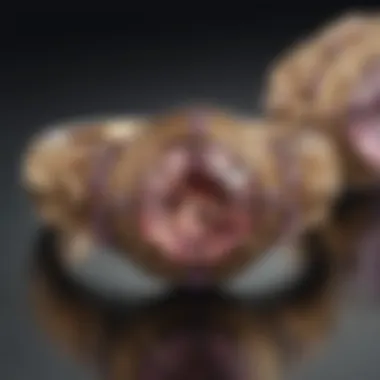
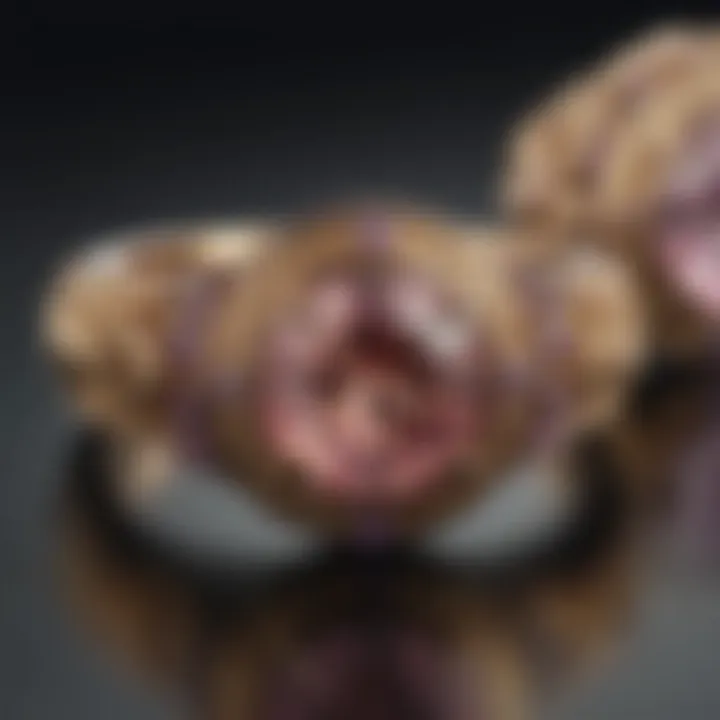
Conversely, modern aesthetics focus on clean lines and minimalistic designs. These are often characterized by contemporary settings and innovative gemstone cuts. A modern engagement ring might embody a sense of sleekness and simplicity that appeals to many today.
Both styles have their merits. If you lean toward elegance and history, vintage may be your path. However, if you prefer contemporary simplicity, modern designs may speak more to you. Assessing both aesthetics helps solidify what resonates most with you, ensuring the final design embodies your true personality.
In summary, defining your personal style is a crucial phase in the process of designing your engagement ring. Assessing current trends provides context, while an exploration of vintage versus modern aesthetics allows for a refined sense of identity. Each choice made here sets the stage for a ring that is entirely yours.
Choosing the Right Gemstone
Choosing the right gemstone is a critical step in designing a custom engagement ring. This decision not only affects the aesthetics of the ring but also influences its significance and personal value. Each gemstone carries unique properties, symbolism, and emotional connotations. Therefore, understanding the available options enables you to select a stone that truly reflects your individual style and the essence of your relationship.
Evaluating Different Gemstone Properties
When considering gemstones, it is essential to evaluate several key properties. Hardness, for example, is crucial. The Mohs scale rates gemstones based on their resistance to scratching, which means a higher score usually indicates better durability. Diamonds, rated a 10, are the hardest, while softer stones, like emeralds or pearls, can scratch easily.
Additionally, reflectivity and brilliance also matter. The way light interacts with a gemstone can heighten its visual appeal. This is especially important for engagement rings, as they are meant to catch the eye. While diamonds are renowned for their brilliance, other gemstones like sapphires and rubies also exhibit impressive light performance.
Considerations for Color and Clarity
Color and clarity are pivotal factors in determining a gemstone's overall quality. Color encompasses hue, saturation, and tone. Some stones, like sapphires, can come in various colors. It’s important to consider personal preferences here. While some may prefer the classic blue, others could be drawn to pink sapphires or even yellow ones.
Clarity involves examining any imperfections or inclusions within a stone. In general, the fewer the inclusions, the higher the clarity grade. However, some gemstones, such as emeralds, often have inclusions that are acceptable, as they contribute to the stone's character. It is often advised to strike a balance between color, clarity, and personal liking, rather than pursuing perfection.
Popular Choices and Alternatives
Most people immediately think of diamonds when selecting their engagement ring's gemstone. However, several alternatives offer unique advantages:
- Sapphires: Known for their durability and variety of colors, sapphires have become a popular choice for modern engagements.
- Rubies: Symbolizing passion and love, rubies are striking and durable, making them an appealing option.
- Emeralds: Their rich green hue attracts many, but awareness of their softer nature is essential.
- Moissanite: A popular diamond alternative, it possesses extraordinary brilliance and is more affordable.
Each alternative has its own merits, and it’s essential to choose based on aesthetic preferences, budget considerations, and inherent meanings. Choosing a gemstone should feel like an expression of unique identity, an emblem of love tailored to the specifics of the relationship.
Choosing a gemstone means more than just picking a pretty stone; it is about selecting a symbol that tells your story.
Deciding on the right gemstone is an enlightening part of the custom ring design process. It invites personal exploration and emphasizes the bond you share.
Metal Options: Which One to Choose?
Choosing the right metal for an engagement ring is a critical aspect of the design process. The metal not only impacts the ring's aesthetic appeal but also determines its overall durability and maintenance requirements. With a variety of options available, understanding the benefits and considerations of each type becomes essential for creating a personalized piece that stands the test of time.
Understanding Different Types of Metals
When selecting a metal for your engagement ring, it is important to match the metal with both personal style and lifestyle needs. Here are some popular choices:
- Platinum: Known for its strength and durability, platinum is an excellent option for engagement rings. It resists tarnishing and requires minimal maintenance. However, it is also more expensive than other metals.
- White Gold: A popular choice that offers a similar look to platinum at a lower cost. White gold is often plated with rhodium to enhance its shine. Regular re-plating may be necessary to maintain its appearance over time.
- Yellow Gold: This classic option provides warmth and a traditional feel. Available in various karats, yellow gold is durable, but softer than platinum or white gold, making it more prone to scratches.
- Rose Gold: This metal has gained popularity for its unique hue and romantic appeal. The copper content gives it a distinctive coloration. It is also durable but more susceptible to tarnishing than other metals.
Ultimately, the choice of metal should reflect personal taste while keeping practical considerations in mind.
The Role of Durability and Maintenance
Durability plays an essential role in selecting the right metal. An engagement ring is worn daily, so it must withstand everyday wear and tear. For example, platinum's resilience makes it ideal for styles that hold a gemstone securely. Conversely, softer metals like yellow gold may require more careful handling to avoid damage.
Various metals also have distinct maintenance needs. Here are some tips to consider:
- Regular Cleaning: Regardless of the metal, regular cleaning is necessary to maintain its luster.
- Professional Inspect: Getting the ring checked by a jeweler periodically will help identify any wear or loose stones that require attention.
- Storage: Proper storage is important for minimizing scratches and damage. Using a soft cloth or a dedicated jewelry box can help protect the ring when not in wear.
Regular maintenance will ensure your engagement ring not only looks beautiful but also lasts for generations.
When designing an engagement ring, metal selection is not merely an aesthetic choice. It embodies both personal style and practical functionality. Careful consideration of metal options ensures that the final piece is not only visually appealing but also a lasting symbol of love.
The Design Process: From Concept to Creation
The design process is the heart of creating a custom engagement ring. It is where visions transform into tangible symbols of commitment. Understanding this process allows one to navigate the complexities of design while ensuring that the final piece is a true reflection of individual style. This journey comprises several key phases, each critical to the successful realization of an engagement ring.
Working with a Jeweler
Establishing a relationship with a jeweler is fundamental. A skilled jeweler plays an essential role in translating your ideas into a physical product. They possess the technical expertise necessary to guide you through design choices, material selections, and functional aspects. When choosing a jeweler, consider their experience with custom designs.
- Research potential jewelers by examining their portfolios and client reviews.
- Schedule a consultation to discuss your vision and gauge their understanding of your needs.
- Ask about their design process and what level of involvement you can expect.
A good jeweler will not only facilitate the design but also help avoid pitfalls. Their insight can help mitigate challenges that may arise during the design and production phases.
Sketching Your Ideas
Sketching is an expressive outlet, allowing you to visualize your ideas. While you do not need to be a professional artist, having rough sketches can significantly enhance communication with your jeweler. Here are some points to consider:
- Start simple: Focus on basic shapes and outlines before moving to details.
- Incorporate inspiration: Look for images or designs online that resonate with you and include them in your sketches.
- Focus on elements: Think about the band style, setting type, and any additional features like engravings.
Creating a visual representation of your thoughts can clarify your desires, making it easier for the jeweler to understand your vision. Sharing sketches can spark constructive discussions, leading to refinements that elevate the design.
Creating a Prototype
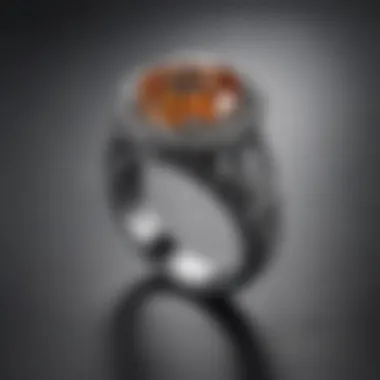
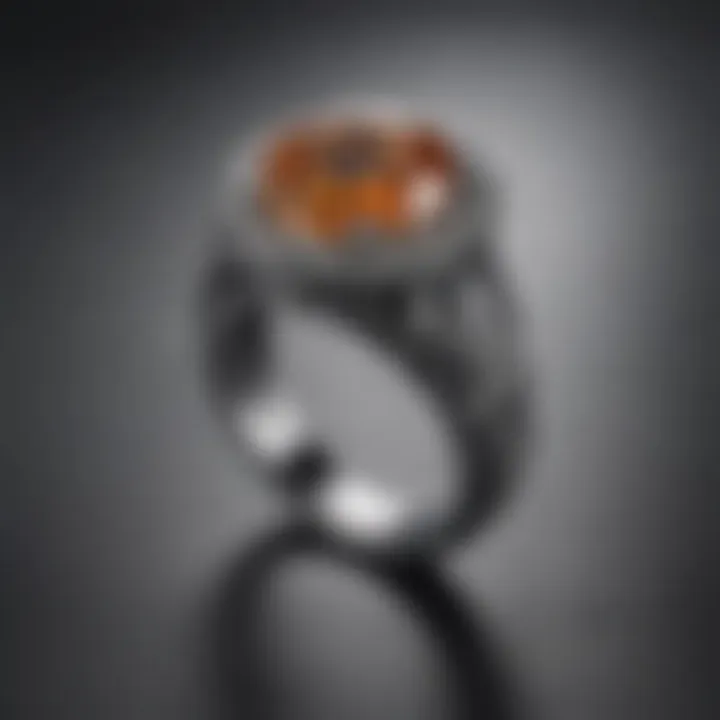
Once sketches are finalized, the creation of a prototype is the next step. A prototype is a three-dimensional representation of the design. This stage is critical as it allows you to see and feel the ring before final production.
- Discuss options: Talk to your jeweler about how they create prototypes. Some may use wax models or digital rendering.
- Evaluate the prototype: Look for fit, comfort, and aesthetics. This is the moment to make any necessary adjustments.
- Final adjustments: If changes are required, be detailed and specific in your feedback to ensure your vision is fully realized.
Prototyping eliminates uncertainties. It provides a tangible way to assess how the ring will look and feel, ensuring satisfaction before moving forward to the final piece.
"Creating a custom engagement ring is a partnership between the client and the jeweler, requiring clear communication and mutual understanding."
The design process incorporates various stages that together ensure a meaningful outcome. Understanding the significance of each step can dramatically enhance the quality and satisfaction of your final design.
Setting Options: Elevating Your Gemstone
When designing an engagement ring, the choice of setting can significantly influence the overall appearance and emotional impact of the piece. The setting holds the gemstone securely in place, but it also plays a vital role in enhancing the brilliance and aesthetic appeal of the ring. A well-selected setting can elevate a simple gemstone into a breathtaking centerpiece. Here, we will explore the various options available and the considerations that should inform your choice.
Understanding Different Types of Settings
Several types of settings exist, each offering distinct benefits and styles. Some popular settings include:
- Prong Setting: This is among the most common types. It uses metal prongs to securely hold the gemstone while allowing maximum light to enter it, which enhances its sparkle.
- Bezel Setting: A bezel setting encircles the gemstone completely with metal, providing excellent protection. This setting is ideal for those seeking durability.
- Tension Setting: This modern style uses tension to hold the gem in place. It appears to float within the band, providing a unique aesthetic.
- Halo Setting: It features a central gemstone surrounded by smaller stones. This design can make the center stone appear larger and add extra sparkle.
Each setting serves different style preferences and practicality. For instance, if you value a vintage look, consider a bezel or halo setting. Conversely, those looking for a more contemporary option may lean towards the tension setting.
The Impact of Setting on Overall Design
The choice of setting can reshape the entire design narrative of the ring. A setting can highlight the qualities of the gemstone while also reflecting personal taste. Choosing a setting that complements the chosen gemstone can ensure that it shines at its full potential.
Here are some factors to consider:
- Height and Profile: The setting can alter how the ring sits on the finger. Low-profile settings provide a comfortable fit, while higher settings allow for more light but may snag clothing.
- Balance of Elements: The setting should harmonize with the band and gemstone. A heavy band may require a different setting approach than a delicate one.
- Versatility: Some settings offer greater versatility, allowing for future adjustments, such as changing the gemstone or adding bands.
A well-chosen setting not only showcases the gemstone but also conveys the emotional significance behind the ring.
Understanding these elements will help you select a setting that enhances both the beauty and the meaning of your engagement ring.
Budgeting for Your Custom Engagement Ring
Budgeting is a crucial step in the process of designing your custom engagement ring. It shapes not only what you can afford but also informs the choices you make concerning materials, gemstone quality, and design complexity. A well-thought-out budget allows for flexibility while ensuring that your creative vision aligns with your financial reality. When considering a custom piece, understanding your financial limitations can help crystalize your options, preventing the common pitfall of overspending. Moreover, a clearly defined budget can enhance communication with your jeweler, facilitating a smoother design process.
Breaking Down Cost Components
To effectively budget for your engagement ring, it is vital to break down the various components that contribute to the overall cost. The key factors include:
- Gemstone: The choice of gemstone plays a significant role in the price. Diamonds are traditional but can be costly. Alternative stones, like sapphires or moissanite, can often provide similar aesthetic appeal at a lower price point.
- Metal: The choice of metal for the band influences the cost. Platinum is more expensive and durable, while gold, whether yellow, white, or rose, offers varying price points based on karat.
- Design complexity: A simple design will generally cost less than intricate features such as filigree or custom engravings.
- Setting style: Different settings like solitaire or halo affect both the aesthetics and cost.
- Warranty or maintenance plans: These extras can add to your total but may provide long-term peace of mind.
Each of these factors contributes to the total expenditure, and a careful evaluation will ensure that each component aligns with your budget.
Balancing Quality and Affordability
Achieving a balance between quality and affordability is essential in creating your custom engagement ring. While it may be tempting to compromise on quality to save money, this choice can impact the ring’s long-term durability and appearance. Significant considerations include:
- Prioritizing essential elements: Focus on the most critical aspects that matter to you. For instance, if the gemstone is important, allocate more of your budget there and keep simpler designs for other components.
- Consultation with Professionals: Engaging a jeweler with a solid reputation can lead to better choices. They can provide wise recommendations for settings and gemstones that offer great quality at reasonable prices.
- Optimize your timeline: Purchasing during off-peak seasons or shopping around holidays can provide better deals and discounts.
"A thoughtful approach to budgeting allows you to obtain the best value without sacrificing the desired quality for your engagement ring."
In summary, dedicating time to budget effectively impacts your overall experience in designing a custom engagement ring. It necessitates a balance that guarantees satisfaction without regret.
Benefits of Custom Engagement Rings
Custom engagement rings offer numerous advantages that set them apart from ready-made options. This distinction is vital, as these advantages are not merely aesthetic; they encapsulate personal expression, lasting value, and the significance of the relationship they symbolize. Each aspect contributes to a unique narrative that reflects the wearer’s journey, making these rings not just accessories but heartfelt connections.
A Reflection of Individuality
Crafting a custom engagement ring allows individuals to express their personal style and preferences. No two people are the same, and a custom design ensures that the ring will represent the specific tastes and characteristics of the individual or couple involved.
Consider how a personal style reflects distinct attributes:
- Design Features: Shapes, settings, and styles can be tailored to match personality. For instance, someone might prefer a minimalist design, while another might opt for an elaborate look.
- Gemstone Choices: Selecting a gemstone beyond the traditional diamond allows for tailored sentiment. Sapphires, emeralds, and other stones can symbolize different meanings or qualities important to the couple.
- Metal Preferences: The choice of metal, whether it is platinum, gold, or even alternative metals like titanium, enhances how the ring aligns with personal tastes.
This personalization not only results in a one-of-a-kind piece but also ensures that the ring tells a story unique to its owner. While choosing a standard design often leads to commonality, custom options break such molds and allow for distinctive representations.
Sentimental Value Over Mass Production
In an era dominated by mass production, creating a custom engagement ring offers profound sentimental value. A ring made specifically for a loved one transcends mere materialism. Here are several elements to consider regarding its sentimental significance:
- Unique Story: Each custom ring is a culmination of thoughts, feelings, and shared experiences. This journey from design to realization adds depth to its meaning.
- Heritage and Family Influence: You can incorporate family heirlooms or design elements that reflect heritage. This connection to the past can add layers of meaning that mass-produced rings simply cannot provide.
- Emotional Investment: Designing a custom ring often involves choices anchored in shared memories or aspirations. This emotional investment fosters a deeper attachment to the piece.
"Creating a custom engagement ring is not just making jewelry; it is crafting a symbol of love that profoundly resonates with the story of a relationship."
In the end, custom engagement rings embody much more than their physical presence. They encapsulate a narrative of love and partnership. The personalization allows connections to elements often overlooked in standardized models, transforming a simple accessory into a cherished token.
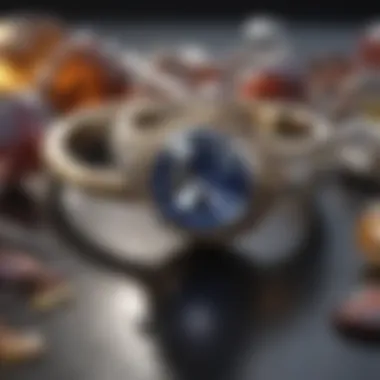
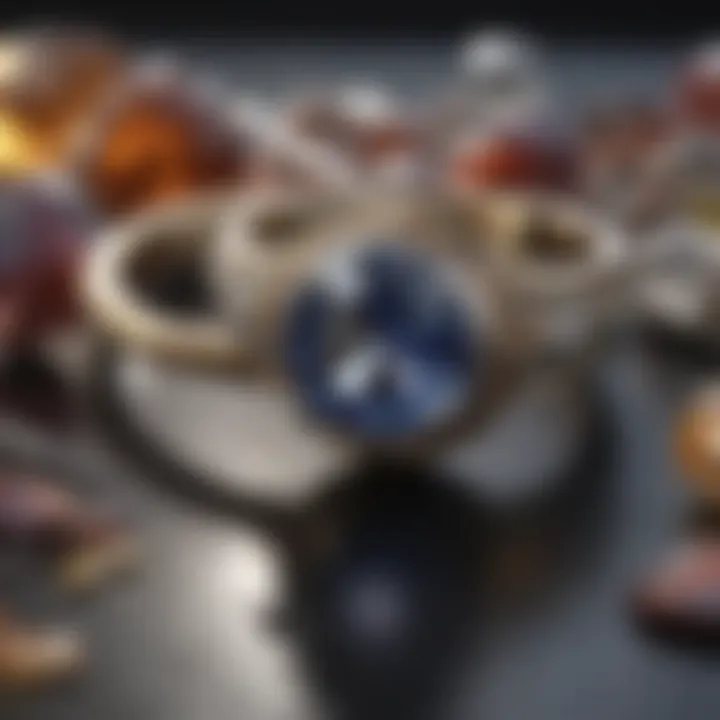
Challenges in Designing a Custom Ring
When embarking on the journey of creating a custom engagement ring, various challenges can arise. It's essential to address these potential hurdles to streamline the process and ensure that the final product meets expectations. Being proactive about possible problems can lead to a smoother experience, reducing frustration on what should be a joyful endeavor.
Potential Miscommunications with Jewelers
One of the main challenges in custom ring design is miscommunication with jewelers. Clear communication is crucial to ensure your ideas translate into a physical representation. Misunderstandings can stem from many factors. Jewelers may have their own interpretations of your vision or may not fully grasp the specifics of the design you propose.
A few strategies can help avoid this:
- Be Specific: Use clear language and avoid vague terms. Clarifying every detail, from the type of metal to gemstone size, helps ensure a mutual understanding.
- Use Visual Aids: Providing examples of designs, whether through sketches or images, can illustrate your ideas more effectively than words alone.
- Ask Questions: Encourage a dialogue with the jeweler. Asking for their input and clarification can reveal misunderstandings early in the discussion.
Staying engaged and communicative throughout the process will help align your vision with the jeweler's capabilities.
Managing Expectations
The next significant challenge revolves around managing expectations. Designing a personalized engagement ring involves many variables, including the availability of materials, the complexity of the design, and the jeweler's timeline. It's common for clients to imagine the finished product without fully understanding the underlying processes.
To manage expectations, consider the following:
- Set Realistic Timelines: Custom designs often require more time than one might initially think. Discuss timeframes upfront and factor in delays that may arise due to sourcing materials or intricate craftsmanship.
- Budget Limitations: Customization can escalate costs quickly. Weigh your options and prioritize features that matter most to you. Engaging in discussions about budget constraints with your jeweler can lead to meaningful adjustments without compromising quality.
- Accept Changes: Sometimes, the perfect design may require modifications during production. Being open to changes can prevent disappointment and foster a more adaptable approach.
While challenges exist in creating a custom ring, a well-planned approach can mitigate many of these issues. Maintaining open lines of communication and adjusting expectations can lead to a successful outcome.
By anticipating these challenges and addressing them positively, you can enhance the overall experience of designing your custom engagement ring.
The Importance of Certification
When embarking on the journey of designing a custom engagement ring, the topic of certification often emerges. The significance of certification cannot be overstated, especially for gemstones. Certification acts as a testament to the quality and authenticity of the materials used. For the buyer, it provides a sense of security and confidence in their purchase. Without proper certification, there is a risk of encountering counterfeit materials or misrepresented quality. This potential pitfall makes understanding certification essential for anyone looking to invest in a meaningful piece of jewelry.
Ensuring Quality and Authenticity
A certification from a reputable gemological laboratory assures buyers that the gemstone has undergone rigorous testing. Institutions like the Gemological Institute of America (GIA) and the American Gem Society (AGS) are recognized for their stringent grading criteria. They evaluate various aspects of gemstones, such as cut, color, clarity, and carat weight. This evaluation is crucial when determining the overall value of the gemstone.
- Cut: Refers to the quality of the gemstone’s facets, significantly affecting its brilliance.
- Color: Evaluates the hue, tone, and saturation of the gemstone.
- Clarity: Assesses the presence of inclusions or blemishes, which can impact the value.
- Carat Weight: Measures the size of the gemstone, often a key factor in pricing.
When a gemstone comes with a certification from a recognized lab, buyers can have peace of mind knowing they are receiving a legitimate and high-quality product. This peace of mind is especially valuable when selecting an engagement ring, a long-lasting symbol of commitment.
"Certification transforms uncertainty into assurance, securing your investment for years to come."
Understanding Gemstone Grades
Gemstone grading systems play a vital role in the world of jewelry purchasing. Each gemstone type has its own grading standards, which are crucial for ensuring overall satisfaction. For example, diamonds follow the four Cs methodology: cut, color, clarity, and carat weight. Other gemstones might incorporate different criteria based on their unique properties.
Understanding these grades allows buyers to make informed decisions. Here are some points to consider:
- Purchase Based on Knowledge: Familiarize yourself with grading standards for the specific gemstone you desire.
- Comparative Analysis: Review multiple graded stones to determine which best fits your preferences and budget.
- Seek Guidance from Experts: Don’t hesitate to consult with jewelers who can explain grading details and provide context-specific insights.
Grading systems ensure that both buyers and sellers are on the same page regarding the quality and worth of a gemstone. By understanding these nuances, buyers are better equipped to navigate their engagement ring purchase, securing a piece that truly reflects their individual taste and commitment.
Care and Maintenance of Your Engagement Ring
Engagement rings are not just pieces of jewelry; they carry deep personal meaning and symbolize a commitment. However, maintaining their beauty and integrity is crucial. Regular care can significantly extend the life of the ring and retain its brilliance. This section delves into the importance of proper maintenance, the benefits of regular care, and specific techniques to clean and store your engagement ring safely.
Caring for an engagement ring involves various steps. It ensures that gemstones remain intact and metals do not tarnish. Proper maintenance reflects the effort put into designing the ring, allowing it to continue shining brightly for years to come. Neglect can lead to damage, making repairs necessary, which may detract from its unique charm.
Cleaning Techniques for Different Metals
Different metals require various cleaning methods. Knowing the right technique can help avoid damage while keeping your ring looking its best. Here are some common types and their respective cleaning methods:
- Gold: For gold rings, use a mild soap solution and a soft brush. Avoid harsh chemicals, as they can scratch the surface. After cleaning, rinse thoroughly to remove soap residues and dry with a soft cloth.
- Silver: Silver tarnishes easily. To clean, use a silver polish cloth specifically made for tarnished silver. You can also create a paste using baking soda and water for stubborn tarnish, applying it gently with a cloth. Rinse well and dry correctly to avoid future tarnishing.
- Platinum: Platinum is resistant to tarnishing, yet it can still accumulate dirt and oils. Use warm, soapy water and a soft brush, then rinse and dry. Professional cleaning is advisable for deeper scratches.
- Palladium: Similar to platinum, palladium does not tarnish. Clean it with warm soapy water, a soft cloth, or use a jewelry cleaner suitable for this metal.
Keeping your engagement ring clean helps maintain its sparkle and shine while avoiding damage to the metal and stones.
Storing Your Ring Safely
How you store your engagement ring is just as crucial as how you clean it. Proper storage prevents scratches and damage. Here are some best practices:
- Use a Ring Box: Store your ring in a dedicated ring box when not worn. This provides protection from dust and potential impacts with other jewelry.
- Separate Storage: If possible, store your engagement ring away from other jewelry. This reduces the chance of scratches or tangling with other pieces.
- Avoid Humidity: Keep the storage area dry and free from humidity. Excess moisture can lead to tarnish or degradation in gemstones.
- Periodic Checks: Regularly check your ring for loose stones or signs of wear. Early identification of issues can prevent more significant problems later.
Maintaining your engagement ring through proper cleaning and careful storage ensures it remains a cherished symbol of commitment, effectively reflecting the love it represents.
End: The Journey of Personalization
Designing a custom engagement ring is not merely an act of choice; it is an intimate journey of personal expression and commitment. This article has explored the various aspects that contribute to that voyage. One significant element is the understanding of individuality. Each ring serves as a representation of the couple's unique love story, symbolizing the bond they share. With a custom design, you create a piece that resonates deeply, making it substantially more meaningful than a mass-produced option.
The benefits of personalization extend beyond aesthetics. For many, the experience of working with a jeweler to select every detail—from gemstones to metal—fosters a rich emotional connection. The ring becomes a tangible expression of the shared values and aspirations between partners. Involving personal stories or family traditions in the design adds layers of sentimentality that a common ring might lack.
A key consideration in this personalization journey is the significance of choices. Each selection, whether it is the choice of a sapphire instead of a diamond or a vintage setting as opposed to a modern one, reflects personal taste and preferences. Here lies the power of intention. It is crucial to assess what these choices mean beyond their surface appeal. This deeper understanding enhances the overall significance of the piece.
"The beauty of a custom engagement ring lies not just in its visual appeal but in the narrative it embodies."
While navigating this journey, being aware of potential challenges is essential. Miscommunication with the jeweler or unrealistic expectations can hinder the experience. An open dialogue and a clear vision can help mitigate these issues. Thus, careful planning and research about materials, designs, and the jeweler’s craftsmanship are vital for a successful outcome.
In summary, the journey of personalization in designing an engagement ring is deeply enriching. It is an exploration of love, identity, and shared dreams. With thoughtful planning, one can craft a stunning testament to their relationship that is both beautiful and symbolic. As such, the engagement ring evolves from a simple adornment into a cherished heirloom that can be passed down, preserving love through generations.







